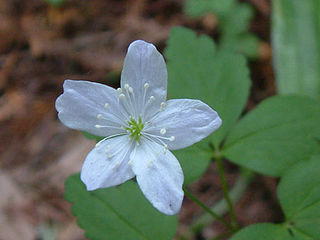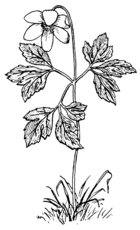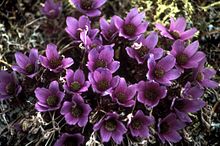
Ranunculaceae is a family of over 2,000 known species of flowering plants in 43 genera, distributed worldwide.

Hepatica is a genus of herbaceous perennials in the buttercup family, native to central and northern Europe, Asia and eastern North America. Some botanists include Hepatica within a wider interpretation of Anemone.

Anemonoides nemorosa, the wood anemone, is an early-spring flowering plant in the buttercup family Ranunculaceae, native to Europe. Other common names include windflower, European thimbleweed, and smell fox, an allusion to the musky smell of the leaves. It is a perennial herbaceous plant growing 5–15 cm (2–6 in) tall.

Adonis is a genus of about 20–30 species of flowering plants of the crowfoot family, Ranunculaceae, native to Europe and Asia.

Knowltonia is a genus of flowering plants in the family Ranunculaceae. There are 25 species native to South Africa and Latin America. The juice from the stem of many of the species in the genus is a powerful vesicant.

Anemone coronaria, the poppy anemone, Spanish marigold, or windflower, is a species of flowering plant in the buttercup family Ranunculaceae, native to the Mediterranean region.

Anemonoides quinquefolia, a flowering plant in the buttercup family Ranunculaceae, is native to North America. It is commonly called wood anemone or windflower, not to be confused with Anemonoides nemorosa, a closely related European species also known by these common names. The specific epithet quinquefolia means "five-leaved", which is a misnomer since each leaf has just three leaflets. A plant typically has a single, small white flower with 5 sepals.

Anemone hepatica, the common hepatica, liverwort, liverleaf, kidneywort, or pennywort, is a species of flowering plant in the buttercup family Ranunculaceae, native to woodland in temperate regions of the Northern Hemisphere. This herbaceous perennial grows from a rhizome.

Anemonoides lancifolia, the lanceleaf anemone or mountain thimbleweed, is an herbaceous plant species in the family Ranunculaceae. The genus occurs in the Southeastern United States. Plants grow 20 to 30 cm tall, growing from a horizontally-orientated rhizome, flowering mid-spring to early summer. The flowers have white sepals that are 12–20 mm long. This species much resembles Anemonoides quinquefolia, of which it was formerly considered a subspecies, except that it is larger growing. After flowering, fruits called achenes are formed in a small cluster; each achene is 3.5–5 mm long, lacks wings and has a straight or partly curved beak that is 1–1.5 mm long.

Anemonoides is a genus of flowering plants in the buttercup family Ranunculaceae. Plants of the genus are native to the temperate regions of the Northern Hemisphere, on the continents of North America, Europe, and Asia. The generic name Anemonoides means "anemone-like", a reminder that many of the species were formerly included within the genus Anemone.

Eriocapitella hupehensis, a species of flowering plant in the buttercup family Ranunculaceae, is native to Asia. The specific epithet hupehensis, which means "from Hupeh province, China", refers to a region where the species is known to occur. In Chinese, it is called dǎ pò wǎn huā huā (打破碗花花), which means "broken bowl flower".

Anemonoides blanda, syn. Anemone blanda, the Balkan anemone, Grecian windflower, or winter windflower, is a species of flowering plant in the family Ranunculaceae. The species is native to southeastern Europe and the Middle East. The specific epithet blanda means "mild" or "charming". The genus name is derived from the Greek word anemos, or wind.

Anemonoides apennina, the Apennine anemone or blue anemone, is a flowering plant in the family Ranunculaceae. It is a rhizomatous perennial plant, native to southern central Europe, taking its name from the Apennine Mountains, but widely naturalised elsewhere in Europe, including the United Kingdom. It can be confused with Anemonoides nemorosa which it resembles. It grows to 20 cm. In early spring it produces single blue flowers above ferny foliage, which dies down in summer. The flowers are about 3.5 cm across, with 10-15 narrow petals. The leaves are palmate with dark green 3-lobed, toothed leaflets. The leaves are hairy underneath, which is how this plant may be distinguished from the similar Anemone blanda. It is especially valued for its ability to colonise deciduous woodlands, but it is also found in open scrub, under park trees, and near former habitation. This plant has gained the Royal Horticultural Society's Award of Garden Merit.

Eriocapitella is a genus of flowering plants in the buttercup family Ranunculaceae. Plants of the genus are native to Asia. The generic name Eriocapitella roughly translates to "growing in a small woolly head", which refers to the hairy ovary and fruit of some members of the genus. Cultivated plants are commonly known as fall-blooming anemones.

Eriocapitella vitifolia, a species of flowering plant in the buttercup family Ranunculaceae, is native to Asia. The specific epithet vitifolia means "vine-leaved, with leaves resembling those of Vitis", the genus of grapevines, and so the plant is commonly called the grape-leaved anemone or grape-leaved windflower. In Chinese, a common name is ye mian hua, which means "wild cotton".

Eriocapitella tomentosa, a species of flowering plant in the buttercup family Ranunculaceae, is native to Asia. The specific epithet tomentosa means "thickly matted with hairs, tomentum (padding)". In Chinese, a common name is da huo cao (大火草), which means "big fire grass" or "great fireweed".
Eriocapitella rupicola, a species of flowering plant in the buttercup family Ranunculaceae, is native to Asia. The specific epithet rupicola means "growing on rocks". In Chinese, a common name is yan sheng yin lian hua, which means "rock anemone".

Eriocapitella japonica is a species of flowering plant in the buttercup family Ranunculaceae. The specific epithet japonica means "from Japan", which is a misnomer since the species is introduced in Japan. It is native to China, Taiwan, and Vietnam.





















